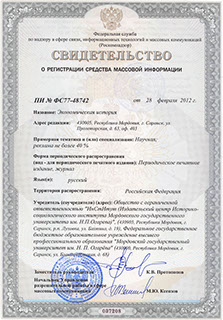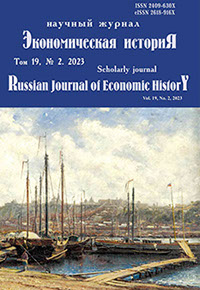Экономическая историЯ
Russian Journal of Economic History
ISSN 2409-630X (Print)
ISSN 2618-916X (Online)
Expert board:
- Scientific Council of RAS on economic history;
- Research and Educational Center «The economic history of Central Russia and the Middle Volga region» of Ogarev Mordovia State University;
- Center of Economic History of Lomonosov Moscow State University
Navigation
Certificate of registration

ISSN 2409-630X (Print), ISSN 2618-916X (Online)
DOI: 10.15507/2409-630X.061.019.202302.159-168
Igor Yu. Asabin
Research Institute for the Humanities under the Government of the Republic
of Mordovia (Saransk, Russia), e-mail: asabin_saransk@mail.ru
Features of Soviet Industrial Development in 1957–1964 (On the Example of the Mari, Mordovian and Chuvash Autonomous Soviet Socialist Republics)
Abstract
Introduction and Methods. The relevance of the work is due to the demand for the experience of the economic council reform, including its regional aspect, at the present stage of Russian modernization. The basis of the methodology of the work is the modernization historical paradigm, aimed at the study of various kinds of progressive transformations of society, noted in the process of its development. The main methods used are comparative-historical, historical-cultural, problem-chronological.
Results and Discussion. The economic councils of the Mari, Mordovian and Chuvash economic administrative regions already in the first years of their existence showed very worthy economic results. The decentralization of the economic sphere, the removal of bureaucratic “obstacles” stimulated the rapid development of new high-tech industries in all three republics: electrical, machine-building, metalworking, instrument-making, etc. However, having given the industrial development of the Mari, Mordovian and Chuvash Autonomous Soviet Socialist Republics a maximum exhausted itself quickly. Founded in the early 1960s the crisis phenomena were expressed in the growth of isolation of the economic regions headed by economic councils as economic cells striving for self-sufficiency (autarky), which gave rise to a number of problems, in particular in matters of supplies between different economic regions, in drawing up plans and their implementation. The regional material of the studied republics eloquently testifies to the typical (universal) nature of such negative manifestations.
Conclusion. For the Mari, Mordovian and Chuvash Autonomous Soviet Socialist Republics, the main result of the economic reform was, in fact, their synchronous transformation from agrarian-industrial to industrial-agrarian regions. The rather rapid pace of this process (1957–1964) can be explained by the decentralization of the economy that occurred as a result of the economic reform, which brought management closer to production and unloaded the industrial management system from excessive bureaucracy. However, the effect of decentralization turned out to be extremely short-lived, since the shortcomings of the territorial administration system soon showed themselves, leading to the rapid exhaustion of its capabilities.
Keywords: economic councils, industrial development, industrial growth, Mari ASSR, Mordovian ASSR, Chuvash ASSR, industrial and agricultural region.
For citation: Asabin I. Yu. Features of Soviet Industrial Development in 1957–1964 (On the Example of the Mari, Mordovian and Chuvash Autonomous Soviet Socialist Republics). Ekonomicheskaya istoriya = Russian Journal of Economic History. 2023; 19(2): 159–168. (In Russ.). DOI: 10.15507/2409-630X.061.019.202302.159-168.
© Ogarev Mordovia State University. History and Sociology Institute, 2017
68, Of. 411, Bolshevistskaya St., 430005, The editorial office of the scholarly journal «Russian Journal of Economic History»
Tel.: (8342) 24-25-90; 27-07-11, Fax: (8342) 24-25-90, E-mail: jurnal-econom-hist@isi.mrsu.ru
Designed by A. Napalkov, Email: napalkov@isi.mrsu.ru

